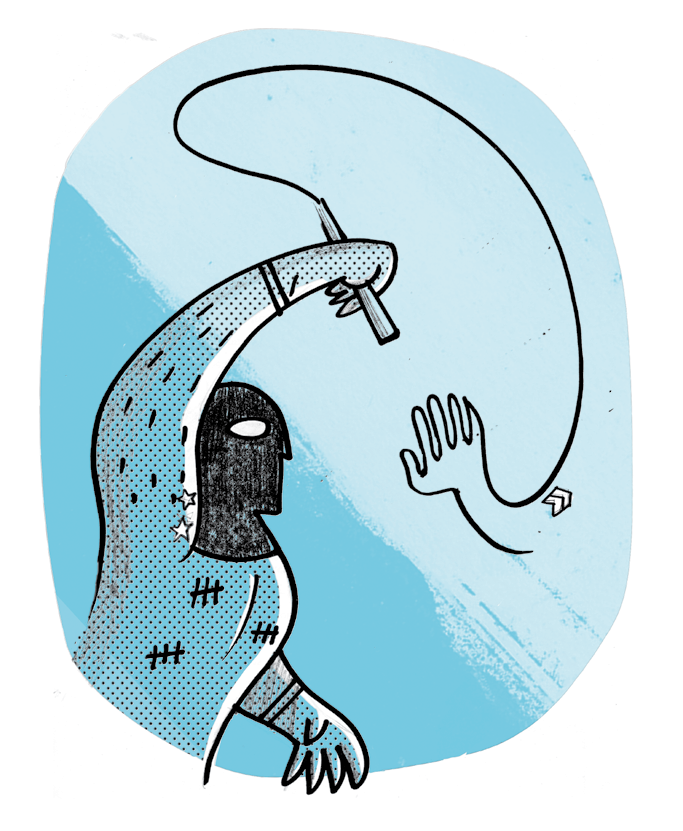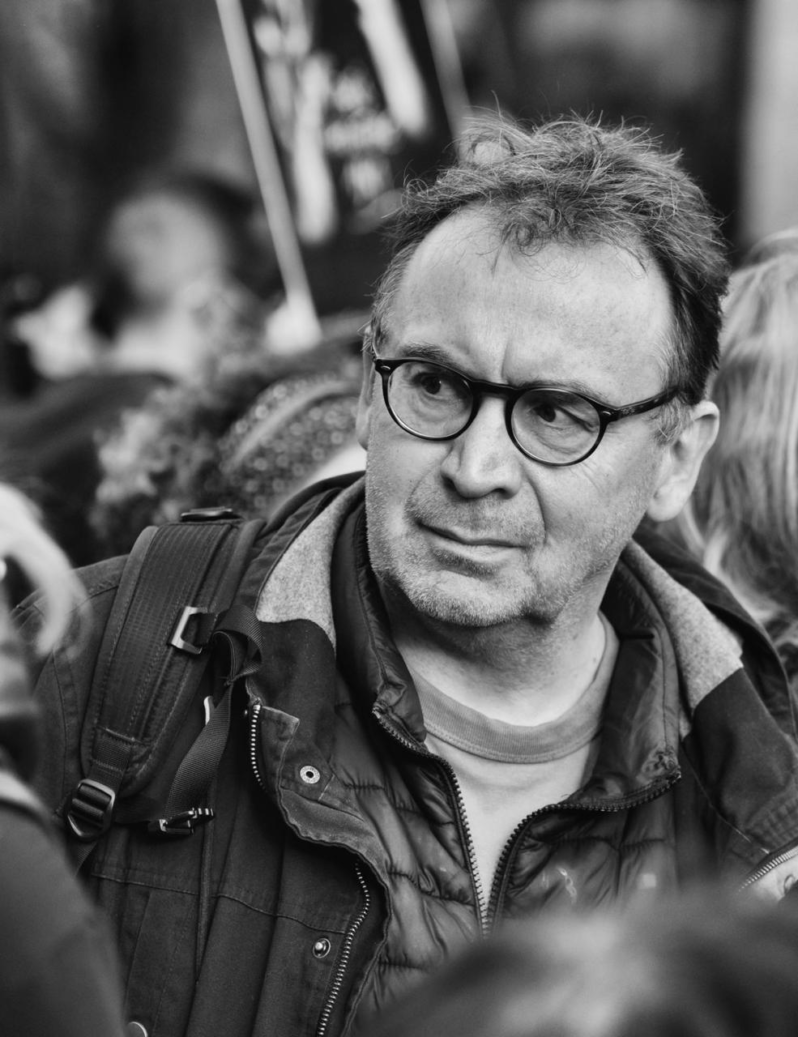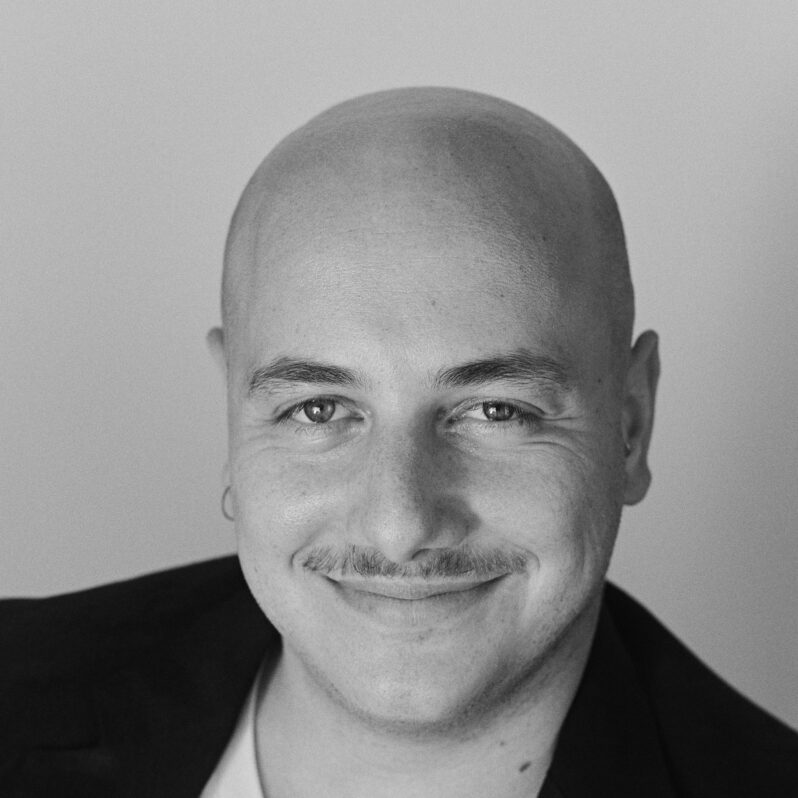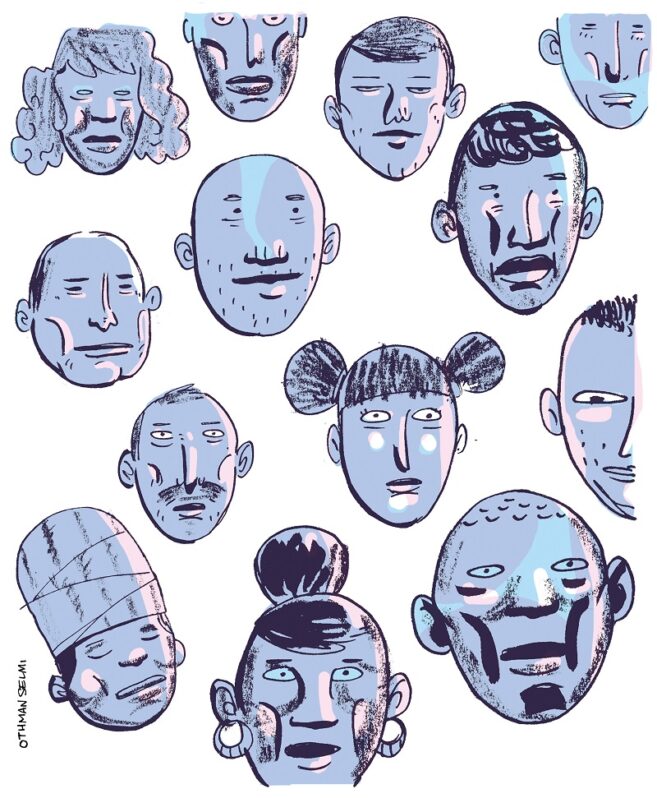Judges and Doctors: Collective Responsibility for Torture in Tunisia

In the early 1990s, Tunisia witnessed a crackdown on Ennahda Movement activists and members that the government at the time justified on the basis that it had uncovered a coup plot by the organization’s secret wing. The movement denied the accusation and argued that the cause of its tribulation was political authoritarianism aiming to undemocratically eliminate a political adversary that had affirmed its presence in the street. The campaign imposed the values of a police state on the Tunisian street, which was at the time governed by fear, and ultimately led thousands of young people to the detention facilities, including those of the courts, amid an official discourse about the discovery of weapons caches, security successes that spared the country from bloodbaths, and political success in uprooting reactionary thought.
A quarter of a century after the campaign of arrests, the public hearings convened by the Truth and Dignity Commission (TDC) freed Tunisian society from the apprehensions that had long governed it. They allowed the victims of torture and the relatives of the missing and murdered to talk about their suffering in front of those who ignored them, in search of a social reconciliation based on bringing down that multi-person, multi-role institution known as “the torturer” [al-jallad]. The hearings revealed that the people the pro-government media portrayed as serious criminals plotting a war to impose their medieval concepts on modernist, progressive society were actually the victims of barbaric practices that long deprived them of the right to live in human dignity. They also revealed that those whom the same discourse portrayed as soldiers in a war against reactionism were the torturers of the period. Via their corresponding details, these testimonies confirmed that torture and abuse of human dignity was systematic, but because they were delivered by people not privy to the secrets of the war waged against them, they could not expose the architecture of those crimes within a state apparatus whose leaders still maintain they did not know about them and label them individual transgressions.
In this context, the indictments that the TDC submitted to refer a number of the perpetrators to the Specialized Judicial Chambers for Transitional Justice are a second step toward exploring the depths of these transgressions to uncover their ramified structure.[1] In several aspects, this structure goes beyond the visible to take form in a collection of complementary and interacting images that were previously state secrets.
Image 1: The Decision-Makers Create the Torturer
The investigations that the investigating judge in the Court of First Instance in Grombalia conducted in the cases concerning the killing of Rasheed al-Shammakhi and Faisal Barakat revealed that at the beginning of October 1991, the National Guard’s general leadership decided, based on a request from the agency’s regional leadership in Nabeul, to reinforce the Research and Investigation Brigade in that region with a special unit from the National Guard’s Central Brigade in el-Aouina. This special unit was to support the National Guard in investigations, raids, and arrests concerning Ennahda members said to belong to the organization’s armed apparatus in Nabeul.
The investigations also revealed that the leadership provided the support force with special resources in the form of new cars and accommodation in a hotel on the Nabeul seashore. The whole way [to Nabeul], the commander of the brigade told his personnel about “the danger of the Ennahda movement”, its coup plot, and the weapons that had been seized from its members. The same speech was later repeated by the commander of the National Guard Commissariat in Nabeul. The commander of the central brigade and his men then entered the regional brigade as distinguished, experienced, and knowledgeable agents favored by the leadership, declaring that they should be in command. Jealousy afflicted the local agents and manifested itself in a desire to outdo their guests in achieving the desired task. Discipline and fear of the leadership concealed this conflict and transformed it into a partnership in complying with instructions that demanded stern treatment of anti-regime elements.
Image 2: The Torturer Devotes Himself to His Work
After drinking alcohol at the Riyadh Hotel, the hunt for wanted persons would begin – hunts in which it was permissible to “detain hostages until the target surrenders himself” and “steal a little jewelry or money that may come under their hands as they search for evidence”. The hunt would always end with detainees. Usually, no reports of their detention were written, and neither the Public Prosecution nor their relatives were informed that they were in custody, amassed naked in the offices and corridors of the security forces’ facilities.
The relationship between the agent seeking professional success and the detainee would lose its humane character for several reasons, including the former’s desire to please his superior, his consumption of alcohol, and his faith in the narrative that he is protecting the nation from terrorists hiding weapons and explosives and plotting to attack the security forces’ facilities.
On 8 October 1991, security agents tied a thin string around victim Faisal Barakat’s penis. Then one agent took a baseball bat and violently inserted it into the victim’s anus using both hands. He removed the bat and put it in his victim’s mouth. The victim, suspended in the “roti chicken” position with his hands bound behind him and blood dripping from his head, was virtually comatose. The agent’s colleague then attempted to master the same game: he tried inserting what resembled a table leg but failed. After he tried once more without success, the experienced officer was compelled to step in and help insert the stick into the anus of the victim, who appeared to be near death. The confusion subsided, and a single question was asked: “Can you see him breathing, or has he died?” The answer: “He will soon”. And that is, in fact, what occurred.
This first death did not dull the enthusiasm for torture within the headquarters. On the morning of 25 October 1991, the “researchers” returned to the headquarters proud of their valuable catch: Rasheed al-Shammakhi, who was, according to the coup scenario they believed, a leader of the armed cell. As soon as he entered, Rasheed was forced to remove all his clothes as the custom there dictated that all detainees, whatever their gender, be naked and barefoot. He was received with slaps to the face and then strikes to the head with a piece of wood until he lost consciousness. He was then placed in the “roti” position, and the experienced agent struck him along his leg with a cane. The agent finished by inserting the cane into the victim’s anus. His colleague, who had learned the technique, stepped in and successfully inserted an iron rod. Amid the victim’s wails, the agents asked, “Where are you hiding the weapons?”. Rasheed crumbled and promised to reveal the location. The agents rejoiced on their way to Rawda park in the middle of the town of Soliman, believing they had succeeded in uncovering a weapons cache. Later, it became clear that Rasheed only wanted the torture to stop. There were no weapons in the park. The agents took him back to the headquarters and took turns torturing him non-stop using the same methods. When he appeared to be nearing death, they nevertheless continued their work with great enthusiasm. They claim that they were “just following orders and compelled to perform their work out of fear for their jobs”.
This image reveals that the torturer believes the narrative about weapons and dreams of successfully seizing them, which would please his superiors and qualify him for being rewarded. He is not deterred from this dream by the blood splatters, nor the victims’ wails, nor even his transformation into a murderer. Hence, the death of Faisal and then Rasheed did not disturb the agents of the Research and Investigation Brigade or their guests. In their minds, it was clear that the state would protect and stand by its personnel who defend its integrity. These expectations were not baseless: their leaders had dispensed lucrative financial rewards to them upon hearing of the atrocities they committed.[2]
Image 3: The Torturer in Defense of a State Accustomed to Fabrication
A doctor claims that on 8 October 1991, he happened to be at a petrol station opposite the brigade’s headquarters. When one of the agents saw him, the agent called him for help, saying that someone inside had been in a traffic accident and needed medical attention. The doctor followed and examined “a person laid out on his back on the tiles in a pool of water, urine, excrement, and blood, completely naked and unconscious, almost not breathing. The doctor kneeled, checked the person’s pulse, and found that his heart was still beating. He also noticed a liquid flowing from his mouth and that he had frighteningly severe bruises, wounds, scratches, and swelling that unusually covered his entire body”.[3] The doctor called an ambulance, which arrived a few minutes later. The victim was taken to hospital, where, after six hours of attempts to save him, he died.
In the early hours of 11 October 1991, two days after Faisal’s death, the commander of the Traffic Guard station in Menzel Bouzelfa recorded in his notebook that an anonymous caller had reported that he had hit someone along Ghurabi road and left him for dead. With the Command Center’s permission, he rushed to the site of the accident. He claims that the commander of the Public Security station accompanied him to the site, where they “found a person sprawled on a narrow rural road with white foam on his mouth, wearing a short-sleeved shirt and pants, barefoot and pale”. While lifting him into the car, they realized he was dead. They contacted the Command Center, which instructed them to take the unidentified body to the regional hospital in Nabeul so that it could be presented to the Technical Police for fingerprinting the following day.
The accident victim, as the Technical Police later confirmed, was Faisal Barakat. Remarkably, the same doctor who examined him in the brigade’s headquarters was the one who conducted the post-mortem and ultimately confirmed the new date of death, though his report mentioned facts that cast doubt over the car accident narrative. The same doctor also examined Rasheed and explained his death as a kidney failure. His presence confirms that a treating physician can be employed in a corrupt state as a torturer who covers up crimes of torture and ensures that the perpetrators escape accountability.
Image 4: The Torturer-Doctor’s Image Does Not Eclipse the Honest Doctor
The doctor composed his medical report while apparently turning a blind eye to the apparent marks of torture. A security officer and higher authorities reviewed this report, and the doctor received a phone call. Fear seemingly prevented the doctor from ascertaining whether the caller was the Minister of Interior himself or someone else from the ministry. But the doctor recalls that the caller said, “It’s the Interior. We trust you and then you write a report like this? What’s the anus got to do with a traffic accident? You’re going to omit these things”.
The surgeon amended the final version of his report as requested. The same doctor composed the second report relating to Rasheed al-Shammakhi without the slightest mention of the marks of torture or the true cause of death. He justifies his action on the basis that “the hospital was surrounded by a large number of agents, and these pressures prevented him from writing the truth”.
The frightened doctor ignored the fact that his wise colleague Jamal al-Din Suwaylim had previously examined Rasheed’s body and written a report documenting all the marks of torture it displayed as evidence against his torturers and attributing the death to torture. He also ignored that his colleague refused to change a single word in his report despite pressure from the hospital’s director and the security forces, upholding the honor of his profession. The agent and the director merely covered up his report and resorted to another doctor to fabricate for them as he had done before.
The image of Dr. Suwaylim and his stances embarrasses many of his professors in the Faculty of Medicine and his colleagues in the various medical institutions. It shows them that the reason they betrayed their profession’s oath was not so much force majeure as it was the fact that they shared values with the torturer, values also shared by judges who claim they were not at liberty to make their own decisions.
Image 5: The Crooked Judge Versus the Honest Judge and the Maneuvering Judge
Rasheed al-Shammakhi was buried on 29 October 1991, in a funeral attended by a large crowd of the people of Soliman despite the security force’s blockade. The victim’s father insisted on exposing the details of the covered-up crime, so he contacted rights organizations. The father’s activism compelled the commander of the security station in Nabeul to send a telegram to the public prosecutor in the Court of First Instance in Grombalia on 31 October 1991, informing him of the suspicious death in the Nabeul hospital. The prosecutor authorized a murder investigation, so Rasheed’s father believed that justice was being done for his son. Hence, on 17 November 1991, the father took the initiative to send a petition to the prosecutor detailing the facts he learned from the witnesses. The investigating judge received him, only to rebuff him and dismiss the case because the criminal in the car accident was unknown. The prosecutor did not appeal the decision despite the information he had received. At this point, it was clear that the judicial proceedings were part of the décor of institutions whose function was to serve the torturer and cover up his crime.
The Specialized Chambers’ case files reveal the strong presence of judges who see and hear nothing and devotedly carry out instructions. However, they also show judges who refused to partake in this dirty game or tried to sidestep the pressures exerted upon them without compromising in telling the truth.
A Professional Judge
Investigating Judge Mundhir al-Luwmi happened to be on duty the night of 17 November 1992. He received notification from his colleague, the Public Prosecution representative, that the prisoner Mawlidi Bin Ali Bin ‘Umar had died in April 9 Civil Prison in Tunis. As the death was suspicious, an investigation was opened, and the investigating judge went to the prison. The presence of the general director of prisons, the regional director of national security, and security agents did not prevent al-Luwmi from including the apparent marks of torture he observed in his report. The judge was subsequently excluded from the investigation. Nevertheless, he stayed faithful to his profession, refusing to partake in the game of serving the regime.
A Maneuvering Judge
On 18 April 1986, student Uthman Shuaybi attempted to evade arrest by a security agent while riding a motorcycle. He headed toward one of the narrow streets of the al-Zuhur neighborhood. The agent drew his firearm and fired a shot, which pierced Uthman’s helmet and killed him. Muddled, the agent and his superiors contacted the regional leadership directly, which authorized an investigation into the matter.
The agents composed a report documenting the facts as they occurred. Meanwhile, Zine El Abidine Ben Ali, who was then “minister director of security”, came to the security station. He viewed the report, became infuriated, and rejected it so that “it isn’t said that the security forces are killing citizens”. He dictated a communique stating that, “During a security operation in the Khaznadar region, security agents stopped a group of bearded men entering a house, where a collection of leaflets were seized. However, one tried to snatch the pistol of one of the agents. Consequently, a stray bullet was fired and hit [the bearded man], and he died”. Ben Ali ordered that this communique be sent to the media. Only then, hours after the event, did the Command Center in the Ministry of Interior contact the assistant public prosecutor to inform him of the event according to its narrative thereof. Ben Ali personally instructed the agent that would accompany the investigating judge, stressing that the judge must not be allowed to examine the body and that any direct discussion between him and the agent that opened fire must be avoided. But Investigating judge Firjani al-Hamruni evaded the blockade plotted for him. As soon as he entered the car, he began chatting with the shooter, and as soon as he arrived at the hospital, he examined the body. Hence, he stated in his examination report that the bullet hit the back of the deceased’s head, completely discrediting the story that the deceased tried to snatch the weapon, and ultimately ordered the agent’s arrest. The judge’s decision left the security agent [sent by Ben Ali to assist the judge] in a quandary. The agent was compelled to take the judge to the regional headquarters to meet the minister. The judge did not oppose the meeting; rather, he appeared to welcome it. The following day, the judge asked to hear the witnesses the region’s mayor would arrange to bring, all of whom corroborated the official narrative.
While this action suggested that the judge had yielded to the pressure and would partake in the fabrication (thereby appeasing the security forces), he defied this expectation by continuing his work gathering evidence. Subsequently, on 10 February 1988, having deduced that the testimonies delivered before him were false because they contradicted his own observations, he issued a decision ordering that the agent in question be sent to trial on the charge of murder. In this manner, the judge avoided a clash with a minister who would become president of the republic just a few months later, without dishonoring his profession. His maneuvering enabled him to uphold the victim’s right and ensured that the offender’s guilt was proven with irrefutable evidence.
These two occurrences confirm that the domination of judges who follow instructions over the Tunisian judiciary’s pre-revolution history does not mean that there were no independent, honorable judges who worked with integrity and strived to do justice. The lack of prominence of such judges is due, firstly, to the fact that observers are unaware of their deeds and, secondly, to the fact that the ruling system avoided assigning “important cases” to them. This system would carefully plan all its cases, exploiting all the state institutions.
Image 6: The Torturer’s Morale Warrants Complete Protection
The archive of the President’s Office reveals that the investigating judge in Grombalia seized a number of documents when investigating the cases of Rasheed al-Shammakhi and Faisal Barakat. These documents show that lawyers, including bar association president Mohamed Chakroun and Radhia Nasraoui, and rights activists, including Khalid Bin Mubarak and Sihem Bensedrine, dug through the cases of grave human rights violations that accompanied the 1991 crackdown. Some of them managed to compel the Committee Against Torture to assume several of the cases, which put the political authorities in an uncomfortable position.
The internationalization of the cases compelled the President’s Office to attend to the issue. Hence, the senior advisors to the president and his ministers dedicated themselves to studying the minister of justice’s suggestions for covering up the scandal. Ultimately, they agreed on the following:
-
That the morale of the security personnel who had done well and made great sacrifices protecting the country’s internal security and “disbanding the spoilers” must be protected, and therefore, no serious investigation into the suspicious deaths – which by then numbered seven – should be allowed.
-
That judicial proceedings aimed solely at providing answers to the inquiries of rights organizations’ in line with the previous official narrative should be initiated.[4]
These memos indicate that the President’s Office, the Ministry of Justice, and the Ministry of Foreign Affairs essentially worked to compose scripts (the official narrative) for judges to memorize and corroborate without exercising any independent reasoning. Trusted lawyers were to join them in the performance, and senior doctors were to be among the accomplices. And so the investigation into the death of Rasheed al-Shammakhi was opened after a brief meeting between the minister of justice, the public prosecutor, and the investigating judge who would assume the case. The investigating judge then assigned a medical committee, as outlined in the memo issued by the President’s Office. The doctors’ work ended as the ministers had planned. Similarly, a lawyer announced that he was representing Rasheed’s family and called for compensation for their damages arising from the traffic accident even though they had not charged him with doing so.
Because of the state’s engagement in systematic torture, its key professions (medicine, the judiciary, law, and the security agencies) witnessed major ethical breaches. Subsequently, all their institutions became embroiled in the state’s crimes. These findings show clearly that an authoritarian regime always remains the primary threat to the construction of the institutions it claims to protect and to the state whose prestige and values it claims to safeguard.
This article is an edited translation from Arabic.
Keywords: Tunisia, Truth and Dignity Commission, Torture
[1] For facts, the indictments relied on the investigations conducted before the courts wherever investigating judges had been responsible for composing the files and assembling their documents.
[2] One of those accused of the violation stated that, “Some material bonuses were distributed. He received approximately 15 dinars, while others – especially the superiors – received more than 100 dinars. Though he had previously been receiving a bonus of no more than five dinars approximately every three months, it is certain that this bonus conferred after the incident was somewhat significant”. Another accused person stated that, “Monetary bonuses were distributed to all the brigade’s agents. He received 50 dinars, considering it an ordinary matter as they had received bonuses of 20 to 30 dinars on occasions prior to that incident”.
[3] Quote from the statement made by the doctor accused of a violation in the case of Faisal Barakat.
[4] A memo to the president from one of his advisors dated 2 September 1992, states,
Regarding the deceased Faisal Barakat, the public prosecutor in Grombalia has been advised that an investigation into the case is being reopened based on information from Amnesty International. The new investigation is limited to appointing a medical committee to study the medical report and submit a second report confirming that the death resulted from a traffic accident, as well as continuing the search for the car that caused the accident. Then, at a subsequent stage, the investigation [will] conclude with dismissal [of the case], and we will inform Amnesty International via the Ministry of Foreign Affairs.



